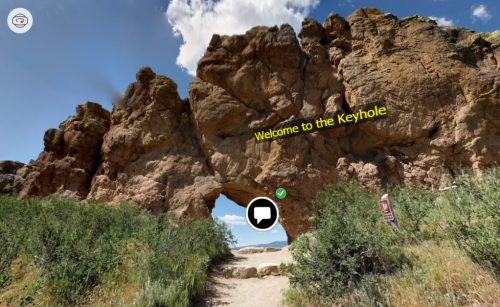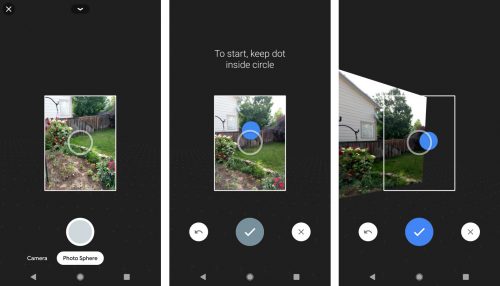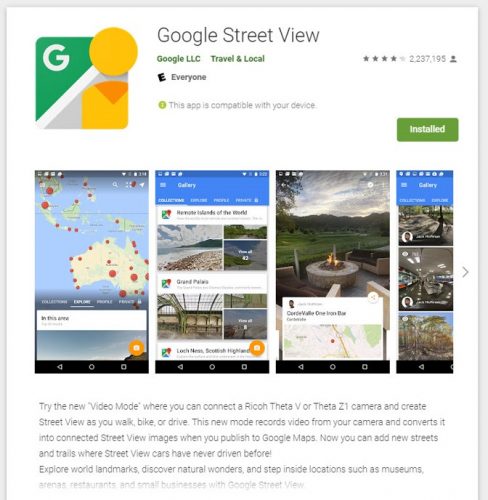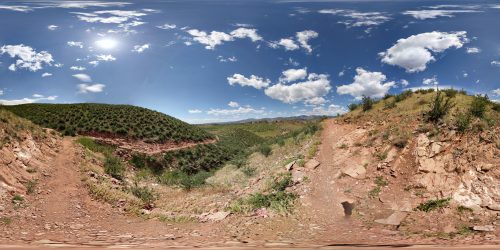Want to utilize 360 VR photos in your Captivate project, but don’t have a big budget to purchase stock photography or a fancy camera? Explore this idea for creating your own 360 photos.
Recently I had the opportunity to speak at Adobe ELearning World 2020. I mostly talked about click to reveal interactions, but what I cut out from the presentation for sake of time, since it was a bit of an ‘extra’, was creating your own VR360 assets, and wanted to share an idea here.
I’ve been so excited about VR in Captivate since it came out in Captivate 2019. There’s so much potential for activities that reinforce awareness of physical spaces that a learner will work in…getting to know your way around a lab, standing in a control room or a server room, or corresponding what you see on a topographical map to the physical world around you.
I feel like lots of people are similarly excited when they see this, but one sticking point is hesitation about where to get 360 images or video.
You probably already know, there are free 360 images and videos when you click on the Assets button in Captivate. Adobe Stock has a growing number of choices that are high quality, and you can Google to find other stock photography sites that have them as well.
One thing I encountered with a client when considering 360 was they didn’t want generic imagery, they wanted imagery of THEIR facility. However, getting that imagery was something they weren’t sure they wanted to invest in.
In that vein, 360 degree cameras can be found on a variety of sites, and the prices are slowly coming down; you can find some good options for several hundred dollars. Often these cameras come with a tripod, many times with an app that will spin the camera around on the tripod (while you hide to avoid being part of the picture).
For many projects, a couple hundred dollars is not realistic, especially if the VR feature would be only a small portion of the project.
The thing is, those pricey cameras can take both 360 photos and VIDEO.
You CAN use 360 video in Captivate, in addition to the 360 photos, which is super.
However, if you have a project that would benefit from 360 photos, and you don’t need 360 VIDEO, I say consider exploring the idea you can take these images on your smartphone.
While on a hike with my neighbor and our respective children, I shot the two 360 images here on my Google Pixel 1 (so, not the newest of phones), without a tripod, and I think they turned out well.
You can see there is a little error in the upper left in the first image, probably I jostled my arm while making the image and a tripod would have been better. That’s the only error in the whole 360 degrees and I personally wouldn’t call it a deal breaker, especially since it’s in the sky.

The second 360 image came out with no such flaws all the way around.

Ha, I am getting better, for both images I did remember to hold the camera in the same spot but step back a bit when shooting the part at the bottom, so there’s not disembodied feet in the images. ![]()
To make this type of photo, I go to my regular camera on my Google Pixel 1 phone and tap an option labeled ‘More’, then Photosphere. From there, the phone walks you through the steps.
You line up the dot with a circle, and the first photo is taken. Then you turn slightly in one direction, and line up the dot with the circle to take the second photo. You continue until you’ve spun around in a complete circle, then raise the camera to take a series of shots for the sky/ceiling, then after that the ground (or vice versa).

Of course, as I mentioned when shooting the ground, remember to hold the phone in place but step back a wee bit so you don’t get your feet. After the last photo is shot, it stitches the images together for you and voila, you have your 360 image.
I am not an iPhone person and haven’t checked to see if a similar option is available natively on iOS. However, you can get the same line-up-the-dot functionality by downloading the app Google Street View. After making a 360 image, you have the option to share your images with Google (which can then be available on Google Maps), or not share and just export out for your own use.

Sometimes my 360s turn out really well, sometimes not so much, and I’m not always sure why. I have more to learn about lighting and have to remember to be mindful of shadows. I’m no professional photographer, but regardless I think this opens the possibilities for being able to create and incorporate custom 360 photos into projects….for free.
Who can say no to potential for creating experiential learning that’s closer and closer to reality? This would be great for things like virtual tours of a museum, safety drills or first responder trainings, or anytime you want a learner to just poke around an environment and get familiar with it.
What are your thoughts? Would you be more likely to utilize 360 photos if you could acquire the photography on your own? Better yet, have you tried this, and how did it turn out? I’d love to hear what you think.
I am having trouble getting the published project to upload properly, so the 360 images themselves are shown below. You can also click the 360Images link to download the two images yourself as a zip file and try inserting them into your own Captivate file.


Yes a Good Idea.
At the moment technology is lagging behind the software. Its a bit like the old days of 3D. Until somene can think of a good use for it. It stays in the hands of the geeks. My own interest is safety but getting access to a site to do some 3D shooting is obviously not practical at moment with Covid.
I was thinking of using some simple office pictures to do a simple course on return to work with Covid in 3D that could look interesting
You must be logged in to post a comment.









